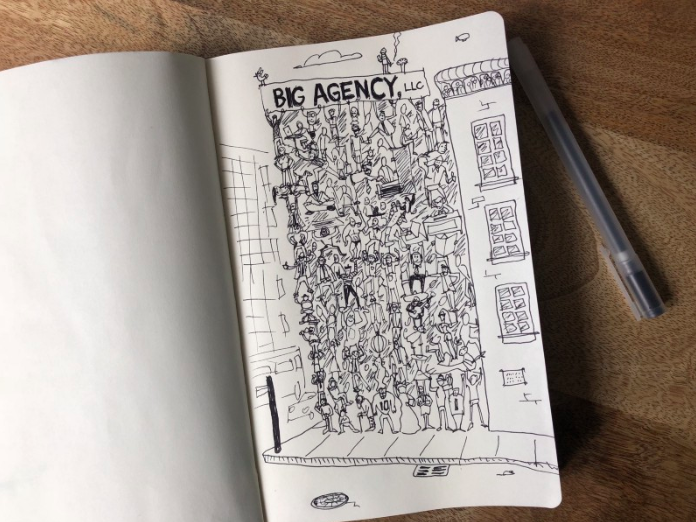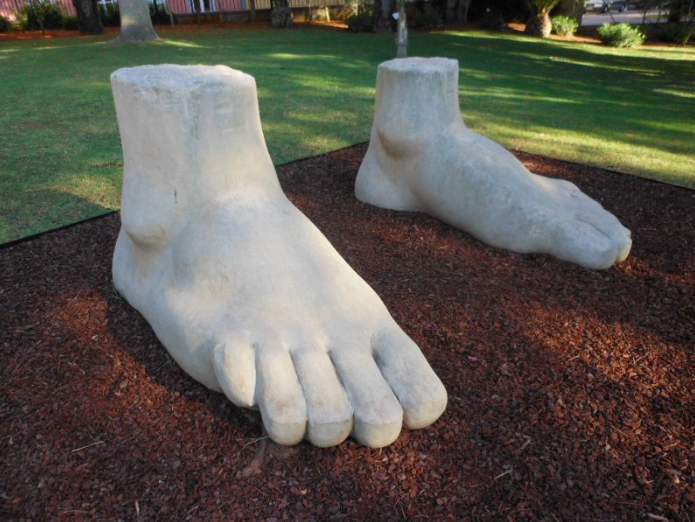There Is No Such Thing As A Big Agency
In my 25 years in the advertising industry (wow, I’m old) I’ve worked at agencies that call themselves “big”. (Ogilvy. BBDO. JWT.) I’ve worked at agencies that call themselves “small”. (Kirshenbaum Bond & Partners. Taxi. Cliff Freeman.) I’ve been an independent freelancer (it doesn’t get any smaller than that) working at agencies on both ends of the spectrum (sometimes at the same time! Cha-ching!). Today I am a Chief Creative Officer and partner at DiMassimo Goldstein, an agency in New York City that is still smallish in size but growing fast.
Last week, I went to the Ad Age Small Agency Conference in Marina Del Rey, California. And I was inspired. Most of the attendees were “big agency” veterans like me who had bravely gone their own way. Sandy Greenberg and Terri Meyer. Bill Oberlander. Anselmo Ramos. Between speakers (and checking in with our teams), we all chatted about what it means to be small in a world that seems obsessed with size and power. In talking with my fellow “smalls”, one thought kept surfacing in my mind: There’s no such thing as a “big agency”.
A global behemoth like Ogilvy may have offices in every corner of the globe. But, in practice, each client gets a team of smart, motivated individuals dedicated to their brand. Example: When I was ECD on a giant financial news account at one of the big agencies above, we did the whole thing with about 20 people in total. That’s including the account team. And planners. Sure, we could call on the power of the network if we needed it. But, day-to-day, no more than 20 people did the work. Sometimes way fewer. And we rocked it. The big global snack company I ran got about the same (and a lot of them were the same exact people, honestly). One mega-client had the largest team in the whole place I would bet. But it amounted to less than 100 people in the end. And they all worked on other things, too. And took weekends off.
Robin Dunbar, a British Anthropologist, coined the Rule of 150, which states that the evolutionary structure of social networks limits us to 150 meaningful relationships at a time. Once a group of humans grows to more than 150 people, the group tends to lose cohesion and want to split up into smaller groups. This is hard wired into our brains from back when we were bands of hunter-gatherers running from tree to tree trying to not be killed by Sabre-toothed Tigers. Paul Lavoie actually used this 150 people rule to run his agencies. Whenever one got close to 150 people, he would go open another one in another city and start all over again. And every client was serviced by no more than four client-facing professionals. This is where the name of his agency network — TAXI — came from, four being the number of people you can fit into the average city cab. Paul knew that clients don’t hire “agencies”. They hire people they trust.
At BBDO, I was lucky enough to get hired to work in Gerry Graf’s group. There were eight creatives in that group. Those eight people made every ad for FedEx, Guinness, Red Stripe, Visa and Snickers. (To be honest, Gerry himself wrote a lot of the ads. He was tough to compete with.) I remember meeting Susan Credle, one of BBDO’s most celebrated ECDs, for the very first time in the halls. She was leaving to go to DDB. (Or was it Leo Burnett?) I shook her hand and she said “Are you new?” I said, “No, I’ve been here for two years.” We had never met until that moment. It makes sense. Susan’s group did M&Ms and AT&T. Were we working at the same agency? Does it matter?
It seems like the market is starting to understand the Big Agency myth. The stock prices of the holding companies have started dropping. Independent agencies are starting to be included in bigger pitches. Maybe technology has made finding great ideas easier. Maybe fracturing audiences and social media have made nimbleness more important than global scale. Maybe talent is realizing its own power and doing something about it. Many of the smartest people I know in this business have chosen to stay “small” as long as they can, at least in spirit. Jay Chiat famously said, “Let’s see how big we can get before we get bad.” But his creative leader, Lee Clow, may have said it best: “It’s more fun to be the pirates than it is to be the navy.” Arrrrr, matey. Arrrrrrrrr.
Another great thing about the smalls is that there’s just so many of them. So you can really find one whose mission aligns tightly with your brand. For instance, at DiMassimo Goldstein, a lot of our clients are direct-to-consumer brands who want to make customers feel like members of a community. We believe in co-creating with the brand team to do things in the world that lead to that result. We call it Inspiring Action. And we’re super passionate about it.
Maybe some boards of directors will always be soothed by the news that the CMO has hired a giant, global advertising agency that they’ve heard of. Nobody ever got fired for doing that, right? And, let’s face it. There’s no replacement for being wined and dined by a holding company exec who has been knighted by the Queen of England. But next time you are tempted to think you absolutely must hire a “big agency”, consider the small. Because in the end, no matter what size your agency pretends to be, all that really matters is the handful of people actually doing the work.
Everything else is just an illusion.



